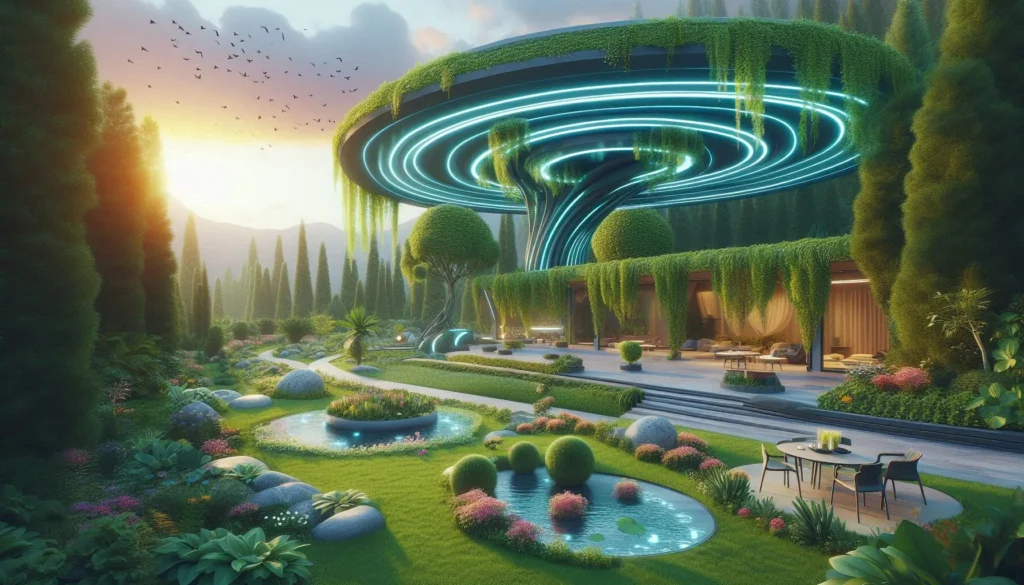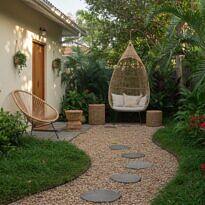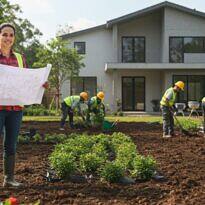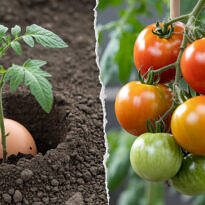The field of landscaping is constantly evolving, shaped by environmental, social, and technological factors. As we approach 2025, new trends are emerging to transform outdoor spaces into more sustainable, functional, and aesthetically innovative areas. Whether for residential gardens or public spaces, today’s landscaping seeks to meet both aesthetic needs and the environmental challenges of the 21st century.
In recent years, themes such as sustainability, connection with nature, and smart use of technology have guided the industry, and 2025 will be no exception! The trends we’ll see this year directly reflect the pursuit of eco-friendly solutions, the appreciation of local flora, and the incorporation of technological innovations. I invite you to explore some of the main directions landscaping is taking and how these changes can transform outdoor spaces.
Focus on sustainability
One of the most prominent trends for 2025 is the increasing focus on sustainability. Sustainable landscaping not only enhances the beauty and functionality of a space but also plays a crucial role in conserving natural resources and promoting environmentally friendly practices. Key approaches include regenerative gardens, the use of eco-friendly materials, and the implementation of urban vegetable gardens.
1. Regenerative gardens: A new approach to cultivation
Regenerative gardens are an evolution of the permaculture concept, prioritizing continuous care for the land and natural resources. Rather than simply creating self-sustaining gardens, landscaping projects in 2025 aim to go further, promoting soil regeneration, biodiversity, and the health of the ecosystem as a whole.
This technique involves planting species that help improve soil fertility and restore degraded areas. Additionally, regenerative gardens integrate rainwater harvesting systems, organic composting, and the use of native plants. These spaces are designed not only to maintain aesthetic harmony but to create a virtuous cycle that benefits the environment in the long term.
Have you heard of regenerative gardens before?
2. Use of eco-friendly materials in landscape design

In 2025, the use of sustainable materials will be a top priority in the design of gardens and green spaces. Landscapers increasingly choose materials that cause minimal environmental impact, such as certified wood, locally sourced stones, and recycled materials. For example, instead of traditional concrete for pathways and communal areas, many projects are adopting options like permeable paving, which facilitates rainwater absorption, or recycled concrete blocks.
Additionally, construction techniques are increasingly focused on reusing materials and reducing construction waste. The use of solar panels to illuminate outdoor areas, efficient irrigation systems, and water pumps powered by renewable energy are examples of how technology can support sustainability.
3. Urban vegetable gardens and food production in residential spaces

Another important trend is the incorporation of urban vegetable gardens in landscaping projects, whether in small backyards or common areas of buildings and condominiums. The idea of growing fresh food at home has gained momentum in recent years, especially with increasing concerns about food quality and reducing ecological footprints.
Urban gardens are not only practical but also aesthetically pleasing. Edible plants, such as herbs, vegetables, and even fruit trees, can be harmoniously integrated into landscape design, providing a space that combines beauty with functionality. Moreover, these gardens bring a social benefit, connecting people to nature and promoting healthier lifestyles.
4. Native plants and biodiversity preservation
With rapid climate change, the use of native plants in landscaping is gaining prominence as an effective strategy for promoting biodiversity preservation. Native plants, adapted to local climates and conditions, require less maintenance and contribute to the sustainability of ecosystems. Additionally, they attract and support native wildlife, such as birds, pollinators, and small mammals, enhancing local biodiversity.
One of the main reasons for the increasing adoption of native plants is their low resource requirements. These species, which have evolved to thrive in specific regional conditions, are naturally more resistant to local pests and diseases and require less water and fertilizer. This makes them an ideal choice for low-water gardens, a trend that is becoming increasingly relevant, especially in areas with water restrictions.
Beyond environmental benefits, native plants can also create unique and highly aesthetic landscapes. They bring distinctive colors, textures, and forms that reflect the natural identity of the region. This enables landscaping projects to be not only sustainable but also authentic and integrated into the local context.
5. Resilient landscaping: Adapting to climate change

With rising global temperatures and the frequency of extreme weather events, the concept of resilient landscaping is gaining traction. This approach seeks to create spaces that can adapt and withstand challenging climatic conditions, such as prolonged droughts or heavy rainfall.
Native plants play a crucial role in this context, as they are already adapted to regional climates, making them more resilient to climatic variations. By choosing species that naturally resist extreme temperatures and water fluctuations, resilient landscaping helps create long-lasting, low-maintenance green spaces without compromising ecological balance.
6. Valuing local flora and its aesthetic applications
In 2025, we will see an even greater appreciation for local flora in landscaping projects. Using native plants not only promotes sustainability but also offers endless design possibilities. The combination of local species allows for the creation of visually striking landscapes, with seasonal flowers, foliage in various shades, and plants that create interesting contrasts with other ornamental species.
Furthermore, there is a growing interest in gardens that reflect the region’s culture and history. Plants that are part of a place’s natural heritage can be used to tell stories and create a sense of belonging. This cultural preservation through landscaping is a way to honor the natural environment and create a unique identity for green spaces.
Smart gardens: Automation and remote monitoring
Technological innovation has revolutionized every sector, and landscaping is no exception. As we approach 2025, the integration of technology in landscaping projects is a trend that continues to gain traction, offering not only efficiency but also unprecedented aesthetic and functional possibilities.
One of the main innovations in landscaping is smart gardens. Using automation and remote monitoring systems, it is now possible to maintain a healthy and well-cared-for garden with much less effort. Technologies such as moisture, temperature, and soil quality sensors allow garden owners and landscapers to monitor plant conditions from their smartphones or other internet-connected devices.
These systems are particularly useful for automated irrigation. By monitoring soil moisture levels, sensors can efficiently trigger irrigation systems, ensuring plants receive the right amount of water and preventing resource waste. Furthermore, some platforms use artificial intelligence (AI) to predict plant needs based on climate data and the garden’s growth history.
7. Use of drones and AI for mapping and maintenance of green areas

The use of drones in landscaping is another trend that stands out for 2025. These devices can be used to map large areas in detail, identifying soil conditions, plant health, and potential irrigation system issues. In larger projects, such as public parks and urban areas, drones facilitate continuous monitoring, allowing for quick and efficient interventions.
Additionally, artificial intelligence is increasingly being used to analyze data collected by drones, enabling more accurate diagnoses and data-driven maintenance strategies. Automation also allows for the execution of repetitive tasks, such as mowing large areas, saving time and reducing labor costs.
8. Sustainable lighting and automated irrigation systems
Lighting is a fundamental element in landscaping, especially in residential and commercial projects that aim to create welcoming environments at night. In 2025, we will see significant growth in sustainable lighting, with fixtures powered by solar energy and remotely controlled via smart systems.
Besides lighting, automated irrigation systems will continue to be a strong trend. Based on weather conditions and soil moisture levels, these systems automatically adjust the volume of water used, saving resources and ensuring plants receive the ideal amount of water for their growth.
Do you already use any technology in your garden? How do you think automation could improve the maintenance of your green spaces?
Multifunctional outdoor spaces
With lifestyle changes brought by the pandemic and the growth of remote work, multifunctional outdoor spaces are becoming one of the most significant trends in landscaping. In 2025, creating green areas that combine leisure, wellness, and productivity will be essential for residential and commercial garden design.
9. The concept of “wellness gardens” and meditation areas

The wellness garden is a concept that is on the rise, especially with the growing interest in mindfulness and meditation practices. These gardens are designed to offer tranquil and relaxing environments where people can disconnect from daily stress and reconnect with nature. Elements such as water features, stone paths, and dense vegetation are used to create a serene atmosphere, inviting introspection and meditation.
Additionally, natural aromatherapy is being incorporated into these spaces, with the planting of aromatic herbs and flowers, such as lavender, rosemary, and jasmine, which promote relaxation through their natural fragrances.
10. Hybrid spaces: Interaction between green areas and remote workspaces
Another trend for 2025 is creating hybrid spaces that combine remote work environments with green areas. With the increase in home office work, many people are looking for ways to bring nature into their workspace, and landscaping can play an essential role in this. Small outdoor offices, like gazebos or decks equipped with Wi-Fi, are becoming popular as professionals seek to work in a more inspiring environment.
These hybrid spaces can be adapted for different functions throughout the day. In the morning, they can serve as remote offices, while in the afternoon, they can transform into socializing areas, relaxation spaces, or even outdoor exercise zones.

11. Balconies and small yards as social gathering spaces
Even in urban environments with limited space, such as balconies and small yards, multifunctional landscaping is becoming an important trend. Instead of treating these spaces as merely decorative, landscaping now transforms them into social gathering areas where friends and family can meet for meals, conversations, or relaxation.
Using modular furniture, which can be easily rearranged, and potted plants allows these small spaces to be used to their fullest, with flexibility for different uses throughout the day. Additionally, solutions like vertical gardens and proper lighting make these spaces functional and aesthetically pleasing.

Increased use of vertical gardens and green roofs
Rising urban density and the search for solutions that promote greenery in limited spaces have driven the use of vertical gardens and green roofs like never before. In 2025, these practices will be even more established, not only as aesthetic elements but also as essential parts of urban sustainability strategies.
12. Vertical gardens in residential and commercial settings
Vertical gardens are an excellent solution for incorporating nature into tight urban spaces. They can be installed in both residential and commercial settings, bringing vegetation to areas where traditional ground-level planting is impossible. Besides their aesthetic appeal, vertical gardens help purify the air, reduce heat in urban areas, and improve buildings’ thermal insulation.
In residential projects, these gardens can be used on balconies, backyards, or even indoors, such as green walls in living rooms and kitchens. In commercial settings, it’s common to see vertical gardens in lobbies, building facades, and common areas, creating an immediate connection with nature and enhancing user experiences in these spaces.
13. Green roofs: Environmental and eesthetic benefits
Green roofs, which have already been adopted in many countries, continue to gain popularity due to their numerous environmental and aesthetic benefits. In 2025, this practice will expand further, both in residential and commercial buildings. Green roofs consist of covering rooftops with vegetation, which helps reduce building temperatures, improve air quality, increase biodiversity, and manage stormwater runoff.
Besides environmental benefits, green roofs also offer a pleasant aesthetic and can be transformed into social spaces or even urban gardens. This allows even densely populated urban areas, such as large cities, to cultivate plants and food on their rooftops.
Innovations in support and irrigation systems for green walls
With the increased adoption of vertical gardens and green roofs, innovations in support and irrigation systems are also emerging. The latest technologies include modular structures that simplify the installation and maintenance of these green walls, as well as automated irrigation systems that efficiently distribute water, reducing waste.
Solutions such as drip irrigation and rainwater harvesting are becoming standard in many projects, allowing these vertical gardens and green roofs to be sustainable and low-maintenance. This ensures that these solutions are viable even for those with limited gardening or maintenance experience.
14. Biophilic Design: Connection with nature
Biophilic design is an approach that seeks to reconnect people with nature, and this trend will continue to rise in 2025. The central idea of biophilic design is to bring natural elements into built environments, improving the well-being and physical and mental health of users.
What is biophilic design and why is it trending?
The term “biophilic” comes from the Greek words “bio” (life) and “philia” (love or affinity) and refers to humans’ innate desire to connect with nature. In an increasingly urbanized world, biophilic design aims to restore this connection by incorporating natural elements such as light, air, vegetation, and water into built environments.
Studies show that spaces designed with biophilic principles can reduce stress, increase productivity, and promote a general sense of well-being. Therefore, in 2025, there will be a growing demand for landscaping projects following this approach in both commercial and residential settings.
Biophilic design can be integrated in various ways in urban environments. Key strategies include using plants (both indoors and outdoors), water features (such as fountains or water mirrors), and creating natural views, like gardens visible from windows and balconies.
Another important aspect is natural lighting. Biophilic projects aim to maximize natural light, creating environments that support circadian rhythms, which are essential for human well-being. Elements like natural textures (wood, stone, natural fibers) are also used to create a more direct connection with the natural environment.
Psychological and physical benefits of biophilic design
Implementing biophilic design offers numerous benefits for physical and mental health. The presence of plants and natural elements reduces stress levels, improves mood, and even increases concentration capacity. In workspaces, this can lead to increased productivity and employee satisfaction.
Additionally, biophilic environments are perceived as more welcoming and relaxing, promoting a higher quality of life both at home and in the workplace. In 2025, biophilic design will be at the heart of landscaping and architectural projects, offering solutions that combine aesthetics, functionality, and well-being.
Natural colors and textures in landscaping
The use of natural colors and textures in landscaping is not new. However, a focus on contrasts and a deeper exploration of textures and colors is consolidating as a strong trend for 2025, as designers seek to integrate gardens and green spaces more harmoniously with nature and the surrounding environment. In addition to creating visually pleasing compositions, the careful selection of colors and textures can influence users’ emotional experience, creating environments that evoke feelings of tranquility, energy, or dynamism.

15. Trends in Nature-Inspired Color Palettes
In 2025, we will see a strong preference for nature-inspired color palettes, emphasizing neutral and earthy tones such as greens, browns, ochres, and beiges, as well as natural shades of gray and white. These colors help create a sense of continuity between the garden and the surrounding natural landscape, fostering a feeling of calm and harmony.
In addition to softer tones, vibrant colors, including various shades of red, orange, and yellow, will continue to be used as focal points, creating eye-catching contrasts in specific areas. Plants with vibrant flowers, like Lantana (Lantana camara) or Daylily (Hemerocallis spp.), are used to create points of interest amidst more neutral vegetation, maintaining a balance between natural aesthetics and visual impact.
The choice of colors in landscaping also follows seasonal changes. In autumn, for instance, plants with foliage that changes color, such as the Japanese Maple (Acer palmatum), take center stage, creating an ever-evolving landscape.
16. Contrasts and Texture Combinations in Contemporary Gardens
Textures are a fundamental element in landscape design, and in 2025, there will be an increasing use of combinations that blend rustic and refined elements. The integration of various surfaces—such as stones, wood, plants with delicate foliage, and shrubs with denser textures—creates a dynamic and visually interesting interplay, adding diversity and aesthetic richness to green spaces.
Plants with contrasting textures can be arranged to create visual and tactile layers. For example, a plant with large, smooth leaves, like the Swiss Cheese Plant (Monstera deliciosa), can be placed next to species with finer and more textured foliage, such as Pampas Grass (Cortaderia selloana), creating a sense of depth and movement.
In addition to plants, hard surfaces like natural stones and wood play a significant role in contemporary landscaping. The use of reforested wood decking, raw stone slabs, or gravel in neutral colors contributes to textures that integrate with the environment while contrasting with the softness of plants.
Low-Maintenance Gardens
A growing trend in landscaping is the creation of low-maintenance gardens designed to reduce the time and resources needed to keep them healthy and beautiful. In 2025, this approach gains even more relevance, especially as people seek to balance the beauty of green spaces with sustainability and the conservation of time and water.
17. Landscaping with Xerophytic and Succulent Plants

Xerophytic plants—those adapted to thrive in environments with low water availability—and succulents are popular choices for low-maintenance projects. Species such as Aloe arborescens, Sedum spp, and Euphorbia tirucalli not only have low water requirements but also add sculptural forms and interesting textures to gardens.
These plants are ideal for regions with drier climates or for those who prefer a garden that does not require frequent watering. Additionally, many succulents and xerophytes bloom in adverse conditions, adding a touch of color even in gardens that receive little rain. However, it’s worth noting that a xerophytic garden in a humid, rainy location may end up requiring more maintenance than a traditional garden.
18. Design Solutions to Reduce Maintenance Needs
It may seem like an obvious choice, but a low-maintenance garden is still not the main goal for many landscapers and garden owners. However, this is an increasingly strong trend.
Beyond plant selection, intelligent design can significantly reduce the amount of maintenance required. One example is the use of ground covers, which minimize weed growth, retain moisture, and help control erosion. Plants like Liriope (Liriope spicata) and Ivy (Hedera helix) are excellent options for ground covers that require little upkeep.
Another common practice is the use of techniques like mulching around plants, which also helps maintain soil moisture, reduces the need for frequent watering, and protects plants from excessive heat.

As we approach 2025, landscaping continues to evolve, reflecting a growing concern for sustainability, functionality, and the aesthetics of outdoor spaces. The trends discussed throughout this article demonstrate how landscape design is adapting to meet future challenges while valuing the connection with nature and the well-being of users.
From incorporating smart technology and automation into garden care to creating multifunctional spaces that promote social interaction and relaxation, landscaping is increasingly aligned with contemporary needs for practicality, sustainability, and health.
The use of native plants and a focus on low-maintenance resources are trends reshaping how we design and care for our green spaces, making them more resilient to climate change and less dependent on intensive interventions. Furthermore, the adoption of biophilic design and the expansion of practices like vertical gardens and green roofs indicate that the pursuit of greater integration between urban and natural environments remains a central theme in contemporary landscaping.
Which of these trends would you like to apply to your space in 2025? If you are planning a new landscaping project, why not consider some of these innovative and sustainable ideas to transform your garden into a space that combines beauty, functionality, and respect for the environment?







